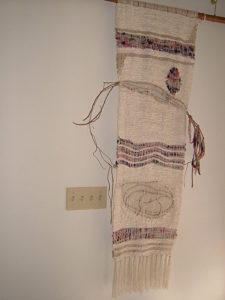 Pulling Ivy – A weaving to commemorate the ivy pullers of the area.
Pulling Ivy – A weaving to commemorate the ivy pullers of the area.
A crafty way to stay out of trouble
By Marilynne Eichinger , Nov. 2016, NFS
Craftiness
As a child, my grandmother and mother used to teach me many of what I think of as “the womanly arts.” At the age of eleven, I was introduced to a sewing machine and made a pinafore. I so proud when I wore it! I remember everything about the process, from pattern to cutting, pinning and sewing with mother there to help every step of the way.
Grandma was a knitter. Her fingers were in constant motion. I went to the neighborhood yarn shop with her and held skeins of yarn that was stretched between my hands while she turned it into a ball. There were usually 7 to 8 women sitting around a big table sharing gossip while their needles went click, click and the sweaters, scarves and afghans rolled down their laps. Grandma taught me to knit and though I made simple items like mittens, hat and scarves I could never duplicate her speed.
Needlecraft and crocheting were two other skills pursued in elementary school. I was reminded of them the other day while cleaning a closet and discovering a lace doily and a towel embellished with flowers. To my great disappointment, the doily had to be discarded because of a large hole.
In sixth grade it was customary for friends to exchange Christmas gifts. There were 17 girls and a teacher on my list… a big burden. So, what did Mom suggest? With her help I made and engraved wooden covers for autograph books. To do so, I learned to use a jig saw, to sand until my arm hurt, and to varnish wood to a deep luster. My wood burning set was employed to embellish the covers. The autograph books were a great success for my friends appreciated the value of homemade gifts.
Today I don’t knit, sew, crochet, do needlepoint or woodwork. However, I paint regularly and dabbled in pottery for a year. These activities make me appreciate the skill and hours that go into well-made handcrafted objects. They also remind me of the warm connection I developed with my grandmother and mother who shared insights that I did not realize would be important in later life.
Part of the craft process is developing a time line, budget and acknowledgment that there are monetary losses with an uncompleted project. I had to problem-solve by deciding what to make, it’s size, design, materials, and color. Math was called into play as I measured and figured the cost of material. Small motor abilities developed as was a modicum of patience and concentration. And, I learned to clean up after each session so my projects would not overwhelm our kitchen.
My activities were quite different from those of my son who takes a more technological approach to crafting. He uses shop tools including welding equipment and connects electronics components to computer controls. He is immersed in artistic endeavors and sponsors craft evenings each Wednesday evening, drawing together artists, computer geeks, and technocrats who enjoy producing unusual sound and visual sculptures.
Artistic endeavors entice children and adults to master skills. They present opportunities for cross-generational groups to work together. Children become appreciative of elders and adults learn from their children who seem to keep up with changing technology.
Arts and crafts are extracurricular activities to most school curriculums, yet being involved with them can affect your child’s life. Patience and the ability to concentrate are skills that carry over to school and work. The thrill that comes from completing a project is a great motivator for future endeavors. The warmth derived from being mentored by a supportive adult builds confidence. And, most important of all, crafts show us how to have lifelong enjoyment.
